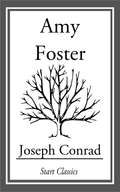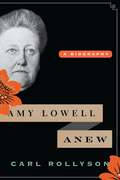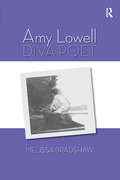- Table View
- List View
Amy Foster
by Joseph ConradThe story of a dull-witted but compassionate English girl who falls in love with a strange man from Eastern Europe. This ignorant, wild, and romantic peasant from the Carpathian Mountains has been cast up by the sea, the only survivor from an emigrant ship bound for America. Unable to speak a word of English and totally mystified as to where he is--it might have been America or Hell, itself--he leads a wretched and hunted existence till the chance kindness of Amy Foster opens his eyes.
Amy Foster
by Joseph ConradIn the nineteenth century, mass immigration changed the face of the world. Although we like to think of this cross-cultural pollination as being a positive trend in human history, the truth of the matter is not always clear. <P> <P> In Amy Foster, prose master Joseph Conrad takes on the dark side of immigration and the intermingling of vastly different cultures and worldviews.
Amy Girl
by Bari WoodEight-year-old Amy Kaslov is pretty and charming, she's been abused and seems helpless, but threaten her and she'll destroy you . . . . It begins with a cool breeze, like a shiver of fear. It swirls into the mind of eight-year-old Amy and she becomes puppet and puppet-master of a terrifying power to make people do things . . . whether they want to or not. But Amy also has the power to touch others with her beauty, charm and helplessness. Detective Joe Levin is drawn to Amy. He wants to protect the terrified orphan who has seen her father murder her mother. Levin takes her home to his wife Jeannie, his daughter Greta, and his troubled teenage son Paulie. That a child who had seen so much hate could still return love seems a miracle. Then Paulie Levin starts a campaign of spite against her, and unleashes a demonstration of Amy's awesome powers of retribution. Could such terror have the face of a beautiful child? Filled with page after page of gripping action and crackling suspense, AMY GIRL is Bari Wood's spine-chilling new novel and the latest example of the edge-of-the-seat storytelling power that has made her a major best-selling author of high-voltage thrillers.
Amy Harrison or Heavenly Seed and Heavenly Dew
by Amy Harrison"Amy Harrison or Heavenly Seed and Heavenly Dew" is a religious text written in 1881 by Amy Harrison.
Amy Herzog's Ultimate Sweater Book: The Essential Guide for Adventurous Knitters
by Amy HerzogA comprehensive guide to knitting sweaters and designing and modifying sweater patterns, by the author of You Can Knit and Knit to Flatter.Yarn and fiber enthusiasts everywhere will celebrate the latest addition to Amy Herzog’s beloved knitting series (which includes You Can Knit That, Knit to Flatter, and Knit Wear Love). This essential guide details every aspect of sweater knitting, starting with instructions for four basic sweater types: yoke, raglan, drop shoulder, and set-in sleeve. Patterns are offered in multiple sizes and yarn gauges for broad appeal. Following the basics for each of the four sweater types are a diverse range of customizing options, including how to add a hood, cowl neck, turtleneck, pockets, and zip or cardigan front, just to name a few. Amy’s clear instruction and expert tips expand the many knitting possibilities, creating the essential knitting resource for knitters everywhere.
Amy Hodgepodge The Secret's Out
by Kim Wayans Kevin Knotts Soo JeongCan a secret break up the friendship of five fourth-grade girls and prevent them from finishing an art project?
Amy Is Famous
by Barbara BottnerThere’s nothing Amy likes more than being famous. It’s so fun to sign autographs for her bear, pose for photos with her parents, and she loves getting gold stars in class. But when a new girl comes to school, suddenly she’s the superstar, and Amy is just super jealous. It's not until they spend time together that they discover something more meaningful than fame—friendship. Themes of sharing the spotlight, overcoming jealousy, and finding great friends take center stage in Amy is Famous, a picture book from renowned children’s author Barbara Bottner.An Imprint Book"Sometimes being famous isn't all that great, but this story of friendship, self-reliance, and overcoming jealousy is." —Kirkus Reviews
Amy Is a Little Bit Chicken: Liz And The Sand Castle Contest; Marion Takes Charge; Amy Is A Little Bit Chicken; Ellie The Flower Girl; Liz's Night At The Museum; Marion And The Secret Letter; Amy On Park Patrol; Ellie Steps Up To The Plate; Liz And The Nosy Neighbor; Etc (The Critter Club #13)
by Callie BarkleyAmy and her friends care for some chickens and prepare for the Santa Vista Quiz Bowl in the thirteenth book of The Critter Club series!Amy has never liked being in the spotlight. When all of her friends decide to form a team for the Santa Vista Quiz Bowl, Amy isn’t so sure it’s a good idea. She knows she can answer the quiz questions…but can she do it in front of hundreds of people? Meanwhile, the Critter Club is caring for a few chickens that need a home. And as the day of the Quiz Bowl gets closer, Amy starts to feel a little bit chicken herself! Will she get over her stage fright and help her team win? With easy-to-read language and illustrations on almost every page, The Critter Club chapter books are perfect for beginning readers!
Amy Lane's Greatest Hits - Amy's Alternative Universe (Dreamspinner Press Bundles #12)
by Amy LaneFrom steampunk to fantasy, don't miss these four favorites of alternative-universe gay romance from Amy Lane in this exclusive bundle! Immortal: As Teyth grows in the craft of metalwork, he also comes to love Diarmuid, the gentle, clever young man who introduces him to smithing. Together, can they keep their village safe and sustain the love that will make them immortal? --Under the Rushes: While Dorjan fights to save the world, Taern joins the battle simply to save Dorjan, knowing everything hinges on the heart of a man in armor and the strength of the man who loves him. --Truth in the Dark: Knife's entire existence has been as twisted as his flesh and his face. He's offered a way out: keep company with Aerie-Smith, cursed to walk upright in the form of a beast, on his island for the span of a year... and perform one "regrettable task" at year's end. --Hammer & Air: Graeme ("Hammer") and Eirn have no words for what they are to each other. They negotiate the dangers of magic and motion, of sex, obsession, and tenderness, hoping to learn the word that can make sense of it all--one word they must earn for themselves.See excerpt for individual blurbs.
Amy Lane's Greatest Hits - Dark Contemporary (Dreamspinner Press Bundles #7)
by Amy LaneLove will survive, but it's a rough road. Don't miss these best-selling tear-jerker contemporary romances from Amy Lane.--Keeping Promise Rock: When Crick's knack for volatile decisions lands him far away from home, Deacon is left, shell-shocked and alone, struggling to reforge his heart in a world where love with Crick is a promise, but by no means a certainty.--Racing for the Sun: When Sonny's ghosts drive them down and run their plans off the road, Ace finds out exactly what he's made of. Maybe Sonny was the one to promise Ace anything, but there is nothing under the sun Ace won't do to keep Sonny safe from harm.--Chase in Shadow: Chase has one chance for true love and salvation. He may have met Tommy Halloran in the world of gay-for-pay--where the number of lovers doesn't matter as long as the come-shot's good--but if he wants the healing that Tommy's love has to offer, he'll need the courage to leave the shadows for the sunlight.--Talker: Brian is outwardly straight, but Talker is desperate for love, and when Talker's behavior leads to some painful consequences, Brian is forced to come out of his closet--in dramatic fashion.See excerpt for individual blurbs.
Amy Lane's Greatest Hits - Light Contemporary
by Amy LaneAmy Lane is famous for her light and quirky contemporary romances. Don't miss these hits: Shiny!: Their unlikely friendship seems like the perfect platonic match until Will reveals how very much more he's been feeling for Kenny almost since the beginning; Going Up!: With a disarming smile and a penchant for drama, Sean laughs his way into Zach's heart one elevator ride at a time; Clear Water: When the worst day of Patrick's life ends with Whiskey saving it, Patrick and Whiskey find themselves sharing company and an impossibly small berth on the world's tackiest houseboat; Gambling Men: Quent Jackson has followed Jason Spade's every move in business and in poker since their first day as college freshmen. Eight years later, when Jace finally decides Quent is the one man he can't live without, he sees no reason for that to change.See excerpt for individual blurbs.
Amy Looks Before She Leaps (The Critter Club #29)
by Callie BarkleyIn the twenty-ninth book of the Critter Club series, Amy meets a blind stray cat!When Amy finds a stray cat who&’s blind, she throws all her time and effort into caring for her. She even wants to skip sleepovers with the Critter Club! But eventually, Amy discovers that the cat can do lots of things on her own, too. It&’s time for the Critter Club to help the cat find a new, loving forever home. With easy-to-read language and illustrations on almost every page, The Critter Club chapter books are perfect for beginning readers.
Amy Lowell
by Clement WoodOriginally published in 1926, this book by Clement Wood is a critical study of the creative work and influence of noted American poet Amy Lawrence Lowell (1874-1925), whose “glittering verses, her militant prefaces and critical studies, her constant packed platform appearances had elevated her to a commanding place,” and had earned her a posthumous Pulitzer Prize for Poetry in 1926. Born in Brookline, Massachusetts, Amy Lowell, who was sister to astronomer Percival Lowell and Harvard president Abbott Lawrence Lowell, published her first work in 1910 in Atlantic Monthly. This was followed two years later by her first published collection of her poetry, A Dome of Many-Coloured Glass.An avid adherent to the “free verse” method of poetry, Amy Lowell became one of the major champions of this method of poetry-writing. Throughout her working life, she was a promoter of both contemporary and historical poets. Her 1921 book Fir-Flower Tablets was a poetical reworking of literal translations of the works of ancient Chinese poets, notably Li Tai-po (A.D. 701-762). Her writing also included critical works on French literature. At the time of her death in 1925, she was attempting to complete her two-volume biography of John Keats, of whom she wrote: “the stigma of oddness is the price a myopic world always exacts of genius.”
Amy Lowell Anew: A Biography
by Carl RollysonThe controversial American poet Amy Lowell (1874-1925), a founding member of the Imagist group that included D. H. Lawrence and H. D., excelled as the impresario for the “new poetry” that became news across the U. S. in the years after World War I. Maligned by T. S. Eliot as the “demon saleswoman” of poetry, and ridiculed by Ezra Pound, Lowell has been treated by previous biographers as an obese, sex-starved, inferior poet who smoked cigars and made a spectacle of herself, canvassing the country on lecture tours that drew crowds in the hundreds for her electrifying performances. In fact, Lowell wrote some of the finest love lyrics of the 20th century and led a full and loving life with her constant companion, the retired actress Ada Russell. She was awarded the Pulitzer Prize posthumously in 1926. This provocative new biography, the first in forty years, restores Amy Lowell to her full humanity in an era that, at last, is beginning to appreciate the contributions of gays and lesbians to American’s cultu
Amy Lowell, Diva Poet: Diva Poet
by Melissa BradshawIn her reassessment of Amy Lowell as a major figure in the modern American poetry movement, Melissa Bradshaw uses theories of the diva and female celebrity to account for Lowell's extraordinary literary influence in the early twentieth century and her equally extraordinary disappearance from American letters after her death. Recognizing Amy Lowell as a literary diva, Bradshaw shows, accounts for her commitment to her art, her extravagant self-promotion and self-presentation, and her fame, which was of a kind no longer associated with poets. It also explains the devaluation of Lowell's poetry and criticism, since a woman's diva status is always short-lived and the accomplishments of celebrity women are typically dismissed and trivialized. In restoring Lowell to her place within the American poetic renaissance of the nineteen-teens and twenties, Bradshaw also recovers a vibrant moment in popular culture when poetry enjoyed mainstream popularity, audiences packed poetry readings, and readers avidly followed the honors, exploits, and feuds of their favorite poets in the literary columns of daily newspapers. Drawing on a rich array of letters, memoirs, newspapers, and periodicals, but eschewing the biographical interpretations of her poetry that have often characterized criticism on Lowell, Bradshaw gives us an Amy Lowell who could not be further removed from the lonely victim of ill-health and obesity who appears in earlier book-length studies. Amy Lowell as diva poet takes her rightful place as a powerful writer of modernist verse who achieved her personal and professional goals without capitulating to heteronormative ideals of how a woman should act, think, or appear.
Amy Makes a Friend (Portraits of Little Women)
by Susan Beth PfefferAmy March wants to be a great artist. She's got the talent; now all she needs is a way to afford art lessons. Her solution: befriend her rich and snobby classmate, Jenny Snow, who'll then invite Amy to sit in on her private art instructions. But Jenny can't be bothered with Amy's friendly overtures -- until Diana Hughes, a new and extremely wealthy girl, chooses Amy as her friend. Now, Amy thinks Jenny will like her too. But the price of art lessons may be higher than Amy ever imagined....
Amy Meets Her Stepsister: Amy Meets Her Stepsister; Ellie's Lovely Idea; Liz At Marigold Lake; Marion Strikes A Pose (The Critter Club #5)
by Marsha Riti Callie BarkleyAmy is excited to meet her new stepsister Chloe. . . but it turns out Chloe doesn't feel the same way Can Amy and Chloe get along? Amy's mom and dad have been divorced for as long as Amy can remember, but nothing prepares Amy for the news she gets on a weekend visit to her dad's house in Orange Blossom: Amy's dad is remarrying In addition to getting a stepmother, Amy will also be getting a stepsister her age named Chloe. As the girls spend more time together, Amy realizes that Chloe isn't as nice as she appears to be in front of the grown-ups. Chloe plays pranks on Amy and is just downright mean to her. Amy worries that she'll be stuck with this stinky stepsister for life. Will she and Chloe ever be friends? With easy-to-read language and illustrations on almost every page, The Critter Club chapter books are perfect for beginning readers.
Amy Moves In
by Marilyn SachsAmy and her family move into a new neighborhood. Amy has many adventures, both good and bad, and makes new friends.
Amy Moves In (Sweet Valley Twins #44)
by Jamie Suzanne Francine PascalJust like sisters... Elizabeth Wakefield is shocked and upset when she hears that her best friend, Amy Sutton's, house has burned down. But she's happy to learn that Amy will be staying with the Wakefields while Amy's parents look for a new home. It will be just like having another sister around. But living with Amy isn't as much fun as Elizabeth thought! Amy treats Elizabeth like her personal maid. And every time Amy talks about the fire, she stretches the truth a little more. Even worse, Amy is spending all her time with Elizabeth's twin sister, Jessica, and the snobby Unicorn Club. Elizabeth is puzzled and hurt. When Amy tells her new friends one of Elizabeth's biggest secrets, it's the last straw. Now the whole school is laughing at Elizabeth! Can she ever trust Amy again?
Amy Signs: A Mother, Her Deaf Daughter, and Their Stories
by Amy Willman Rebecca Willman Gernon“Thirty-seven years ago, I vowed to write a truthful book about raising a deaf child.” Rebecca Willman Gernon followed through on her promise with her deaf daughter Amy Willman in this extraordinary new narrative. Many stories have been told about a parent’s struggle to help her deaf child succeed in a mostly hearing world. Amy Signs marks a signature departure in that both Rebecca and Amy relate their perspectives on their journey together. When she learns of 11-month-old Amy’s deafness in 1969, Rebecca fully expresses her anguish, and traces all of the difficulties she endured in trying to find the right educational environment for Amy. The sacrifices of the rest of her family weighed heavily on her, also. Though she resolved to place four-year-old Amy in Nebraska’s residential school for deaf students, the emotional toll seemed too much to bear. Amy’s view acts as the perfect counterpoint. Interwoven with her mother’s story, Amy’s account confirms that signing served her best. She summarizes life in boarding school as “laughter and homesickness.” She laughed with all of her deaf friends, though felt homesick at times. Amy thanks her mother for the gift of sign, asserting that a mainstream education would never have led her to earn a master’s degree and later teach American Sign Language at the University of Nebraska. Amy Signs is a positive albeit cautionary tale for parents of deaf children today whose only choice is a mainstreamed education.
Amy Snow: A Novel
by Tracy ReesWinner of the UK’s Richard & Judy Search for a Bestseller Competition, this page-turning debut novel follows an orphan whose late, beloved best friend bequeaths her a treasure hunt that leads her all over Victorian England and finally to the one secret her friend never shared.It is 1831 when eight-year-old Aurelia Vennaway finds a naked baby girl abandoned in the snow on the grounds of her aristocratic family’s magnificent mansion. Her parents are horrified that she has brought a bastard foundling into the house, but Aurelia convinces them to keep the baby, whom she names Amy Snow. Amy is brought up as a second-class citizen, despised by Vennaways, but she and Aurelia are as close as sisters. When Aurelia dies at the age of twenty-three, she leaves Amy ten pounds, and the Vennaways immediately banish Amy from their home. But Aurelia left her much more. Amy soon receives a packet that contains a rich inheritance and a letter from Aurelia revealing she had kept secrets from Amy, secrets that she wants Amy to know. From the grave she sends Amy on a treasure hunt from one end of England to the other: a treasure hunt that only Amy can follow. Ultimately, a life-changing discovery awaits...if only Amy can unlock the secret. In the end, Amy escapes the Vennaways, finds true love, and learns her dearest friend’s secret, a secret that she will protect for the rest of her life. An abandoned baby, a treasure hunt, a secret. As Amy sets forth on her quest, readers will be swept away by this engrossing gem of a novel—the wonderful debut by newcomer Tracy Rees.
Amy Snow: A powerful, warm-hearted and uplifting tale about love and friendship
by Tracy ReesUnlock the secret with the Richard and Judy bestseller. Perfect for fans of The Angel Tree by Lucinda Riley, The Lake House by Kate Morton and Dinah Jefferies' The Tea Planter's Wife.Abandoned on a bank of snow as a baby, Amy is taken in at nearby Hatville Court. But the masters and servants of the grand estate prove cold and unwelcoming. Amy's only friend and ally is the sparkling young heiress Aurelia Vennaway. So when Aurelia tragically dies young, Amy is devastated. But Aurelia leaves Amy one last gift. A bundle of letters with a coded key. A treasure hunt that only Amy can follow.A life-changing discovery awaits . . . if only she can unlock the secret.Discover more from Tracy Rees with her next heartwarming historical mystery, Florence Grace.(P)2015 WF Howes Ltd
Amy Snow: A powerful, warm-hearted and uplifting tale about love and friendship
by Tracy Rees'A tenderly evoked and compelling read. The House at Silvermoor deserves to be a huge success' Rachel Hore, author of The Love Child'I loved The House at Silvermoor. Tracy's writing is always so warm and the story is both romantic and compelling' Rosanna Ley, author of The Lemon Tree HotelAbandoned on a bank of snow as a baby, Amy is taken in at nearby Hatville Court. But the masters and servants of the grand estate prove cold and unwelcoming. Amy's only friend and ally is the sparkling young heiress Aurelia Vennaway. So when Aurelia tragically dies young, Amy is devastated. But Aurelia leaves Amy one last gift. A bundle of letters with a coded key. A treasure hunt that only Amy can follow. A life-changing discovery awaits . . . if only she can unlock the secret.'I adore Tracy's writing and have from the moment I read Amy Snow when it first came out. The House at Silvermoor is a sweeping saga full of likeable characters. What a joy to read!' Lorna Cook, author of The Forgotten Village'Tracy Rees has a rare gift for making us care about her characters from the very first pages. I rushed to pick up my copy in any spare moments, because I needed to know what would happen next. It's a compassionate and compelling novel, with a heart-warming love story at its core' Gill Paul, author of The Lost Daughter'A rich, riveting and romantic read' Joanna Courtney, author of Blood Queen
Amy Snowycoat's Daring Dive: Book 20 (Magic Animal Friends #20)
by Daisy MeadowsBest friends Lily and Jess are in the magical land of Friendship Forest for a Swimming Gala. But the beautiful Shimmer Lake is slowly rising... and won't stop! Can the girls and shiny seal pup Amy Snowycoat defeat wicked witch Grizelda before the Sapphire Isle is flooded completely?






















